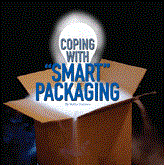L’année 2010 fût très riche en conférences et présentations. Voici un condensé de mes diverses communications:
1. Emballage : Se démarquer et se faire remarquer. Cliquez
ici pour télécharger cette conférence que j’ai donnée la dans le cadre des conférences « Mangeurs sous Influence » organisées à l’occasion du SIAL 2010.
L'emballage protège ce qu'il vend et vend ce qu'il protège. Il est devenu le support privilégié et le partenaire incontournable des nouvelles méthodes de communication des produits alimentaires. Un formidable vecteur de communication et un véritable support publicitaire: l’emballage est la première expression de la marque sur le lieu de vente, c’est le «vendeur muet».
2. Emballage Flexible: Vert, Innovant et Emballant. Cliquez
ici pour télécharger cette conférence que j’ai donnée le cadre de l’atelier thématique : Tendances et innovations dans les emballages flexibles organisé par le Consortium de recherche en plasturgie et composites du Québec.
Les tendances socioculturelles en pleine mutation (nomadisme, emballages actifs et intelligents, développement durable, éco-conception…) et une demande toujours plus grande pour la sécurité (préservation et prolongation de la durée de vie, traçabilité…) et le confort (facilité d’ouverture et de fermeture, praticité…) sont les principaux moteurs de l’innovation en emballage alimentaire.
3. Cascades : Repenser l’emballage par la performance et l’innovation verte. Cliquez
ici pour télécharger cette conférence que j’ai donnée dans le cadre de du cours sur les emballages éco-responsables à L’École de design industriel de l’UdeM.
Depuis ses débuts, Cascades, a privilégié la fabrication de produits éco-conçus respectueux de l’environnement. Pour Cascades l’éco-conception est une source d’innovation et une démarche profitable. Plusieurs exemples d’emballages industriels éco-responsables ont été présentés.
4. Emballage des Viandes : Éco-responsable, Actif & Intelligent. Cliquez
ici pour télécharger cette conférence que j’ai donnée dans le cadre de du cours sur « Les procédés de conservation des viandes » à la Faculté de Médecine Vétérinaire de l’Université de Montréal à St-Hyacinthe.
Voici un aperçu des 3 thèmes qui ont été abordés : 1) Emballage: un ami de l’environnement!: Les comportements à encourager doivent rester la Réduction à la source, la Réutilisation et le Recyclage. Les bioplastiques n’ont vraiment de valeur ajoutée environnementale que lorsqu’il n’est pas possible d’envisager les 3R. 2) Emballage : un partenaire actif! Les emballages actifs limitent le recours aux conservateurs et sont bénéfiques pour la sécurité alimentaire et la réduction du gaspillage. 3) Emballage: un indicateur intelligent! En proposant des dispositifs d’information qui «parlent» directement au consommateur, les emballages intelligents devraient permettre de garantir la traçabilité, la qualité et la sécurité des produits jusqu’au consommateur.
5. Bio-coatings for corrugated boxes: bio-resin and water-based coatings. You can download
here this talk given last November 3-5, 2010, at the Swissotel in Chicago, IL, USA for the by RISI’S 14th International Containerboard Conference.
1. Why wax is on the wane?
2. Market drivers: Sustainability is a Shared Responsibility
3. Bio-coated paper and paperboard: Renewable & Compostable
4. Water-based Barrier: Repulpability, an Important Route to Sustainability
5. Take home…
Par l’ailleurs, c’est déjà confirmé, en 2011, je serai au (Cliquez sur le titre pour accéder au programme complet):
I will attend the Pira International's fifth annual Sustainability in Packaging conference, February 22-24, 2011 in Orlando, FL, USA. I will give a speech entitled: Case Studies: Functional and Sustainable Paper-based Packaging.
• Paper-based Packaging: versatile and responsible
• Repulpability an important route to sustainability
• Water-based coating on paperboard
• Sustainable and functional barrier
I will attend the 2011 TAPPI PLACE Flexible Packaging Symposium, April 5, 2011, in Orlando, FL, USA. I will give a speech entitled: Biopolymers and Biopolymers Compounds in Durable Engineering Applications
1) Flexible Packaging: Convenience and sustainability
2) Paper-based packaging: the responsable Package
3) Paper-based Packaging: Missing performance characteristics and barrier properties
4) Extrusion coating of Biopolymers on Paper-Based Flexible Packaging
5) Water-based coatings lamination of bio-based films to paper
 Mes nouveaux engagements et mes nombreux déplacements m’ont laissé moins de temps pour bloguer. Je dois aussi partager ce temps consacré au web 2.0 avec les nouveaux médias sociaux, Twitter (ici) et le Groupe que j’ai crée sur LinkedIn : PAPER-BASED PACKAGING (ici).
Mes nouveaux engagements et mes nombreux déplacements m’ont laissé moins de temps pour bloguer. Je dois aussi partager ce temps consacré au web 2.0 avec les nouveaux médias sociaux, Twitter (ici) et le Groupe que j’ai crée sur LinkedIn : PAPER-BASED PACKAGING (ici). 



















